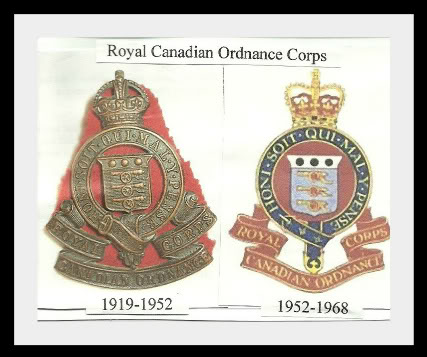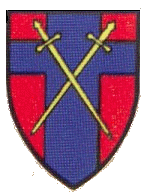Baor(27CIB) surfers,
Installment No. 29, Royal Canadian Ordnance Corps
The following research sources were used to support the summary which follows:
1. Historical Report No. 51
2. The History of the Corps taken from the Royal Canadian Ordnance Corps
Standing Orders
3. Canadian Army 'Network'
From Historical Report No. 51
Page 7, Para 16 ''R.C.O.C. - to form 27th Canadian Infantry Brigade Ordnance
Company No. 7 Infantry Divisional Ordnance Field Park, Halifax, N.S.''
Page 9, Para 25(b) '' designated 'Support Units', 27th Canadian Infantry Brigade
Ordnance Company, R.C.O.C.''
Para 25(c) '' designated 'Base' Units, No.1 Canadian Vehicle Detachment
R.C.O.C.
No.1 Canadian Base Ordnance Unit, R.C.O.C.
Page 15, Para 43, '' The first group to move by sea was a base advance party of
8 officers and 130 O.R. including R.C.O.C. personnel to handle stores, ammunition,
and vehicles. This group arrived at Hamburg on 14 Oct.''
Page 16, Para 50 ''Shortly after its arrival in Germany, 1 Canadian Base Ordnance
Unit sent back to the United Kingdom a detachment to be located with the Base
Ordnance Depot at Bicester, Oxfordshire. This BOD is a unit of the British Army.
It therefore became necessary to place the Canadian detachment under
command of the BOD Bicester for operations, and under command Canadian
Army Liaison Establishment (London) for local administration.
From Network reported by Doug Townsend on 9 Mar 2003,''No. 27 Ordnance
Company, R.C.O.C. and No.1 Canadian Base Ordnance Unit RCOC which was
established at Antwerp, Belgium was part of the total Canadian contingent
and administered by HQ 27 CIB; these two units supplied the brigade with all its
needs including repair parts, clothing, ammunition. In addition the small HQ
established at Antwerp had the task of facilitating the movement by sea of
freight and other stores through the nearby docks to and from Canada and to
and from the Operational Units. This together with associated logistic units
became known as Headquarters Canadian Base Units Europe (HQ CBUE).''
'' A Soldier Apprentice Plan, in operation from 1952 until the early 1960's,
offered 16 to 18 year-old males , with Grade 8 education of better an opportunity
for trades training, progress in schooling, and military training. This Soldier
Apprentice Plan comprised a seven-year program from from Recruit to becoming
a trained Soldier/Tradesman. Following basic training they received two six
month blocks of concentrated secondary school education in math, science, and
English or French. In the last six six-month block, the apprentices received in-
depth training in one of three trades of their military branch. Upon successfully
completing trades training, soldiers transferred to a Regular Army Unit. These
Canadian Army 16 to 18 year old Soldier Apprentices were encouraged to form Boy
Scout troops and Rover crews, in their off duty hours and continue with their
Canadian Scout or Rover programs within the Canadian Army, in Germany and seek
friendships with with youthful British Soldier Apprentices (who were also in British
Scout Troops or British Rover Crews) and membership in the British Army Rover
Crews. It was from these 27 CIBG Canadian Army Scout troops and Rover Crews in
Northern West Germany from 1952 and 1953, whose members joined the Regular
Army, to continue their apprenticeships, in Germany.''

From ''The History of the Corps from the Royal Canadian Ordnance Corps Standing Orders''
The Canadian Ordnance Corps received its Royal designation from King George V in 1919 and the badge was described as follows, ''On a field of scarlet, a central shield of azure depicting the Ordnance Arms comprised of three field pieces under three canon balls. On the encircling garter, the Moto 'Honi Soit Qui Mal Y Pense' followed below with the gilt words 'Royal Canadian Ordnance Corps' and capped with the Tudor Crown, which was replaced with the Crown of St. Edward in 1952. The Standing Orders also list the Regimental March as the 'Village Blacksmith' which is used for the quick march of the regular infantry rate of 120 paces to the minute. Sadly, the Royal Canadian Ordnance Corps no longer exists in the Canadian Military as a result of its integration in 1968 to become the Logistics Branch.
Next installment: Canadian Intelligence Corps, No. 2 Field Security Section
No 27 Canadian Public Relations Unit

